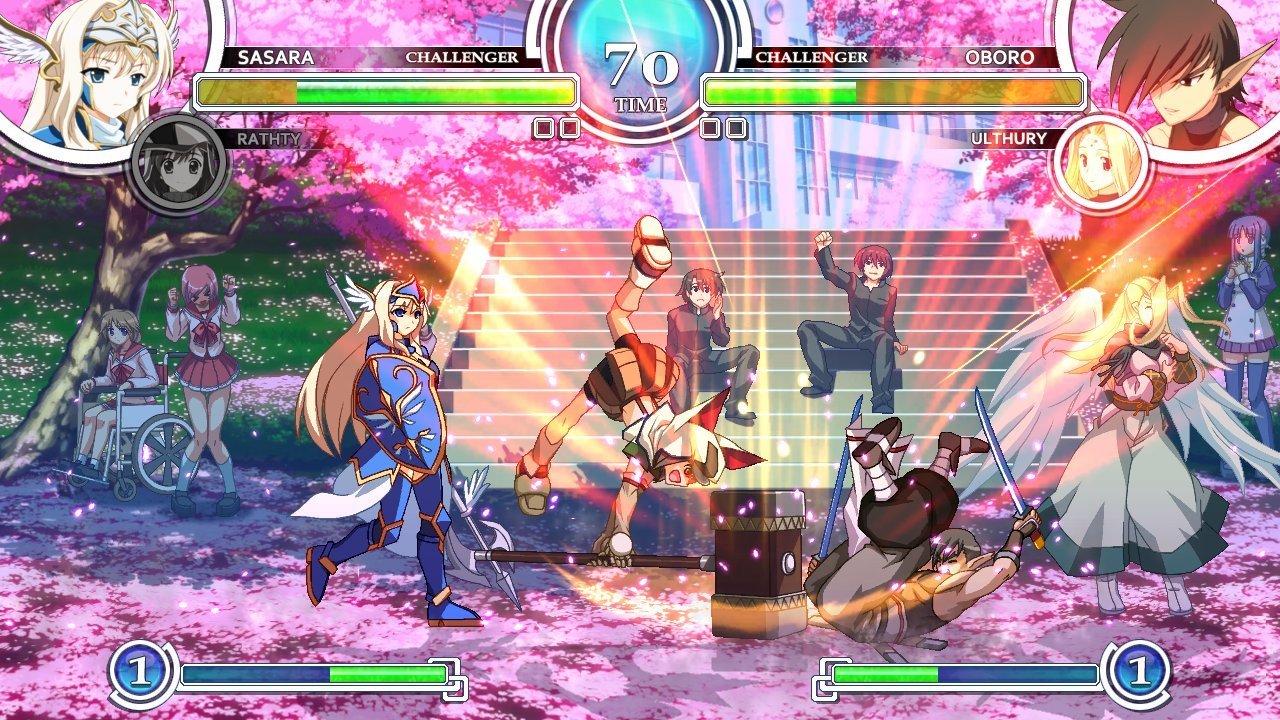Among the fighting games released last year, one that crept under the radar, but drew the attention of some of those in the fighting game scene was Nitroplus Blasterz: Heroines Infinite Duel. This was the latest of a number of various fighting games based on dating sims and visual novels, starting from Melty Blood in 2002 (based on Tsukihime), and moving on through Fate/Unlimited Codes in 2008 (based on Fate/Stay Night – the anime series of which I’ve previously reviewed). In 2013, we got Aquapazza Dream Match, a fighting game based on the various visual novels created by development studio Aquaplus. Now, while Melty Blood and Fate were based on visual novels with their share of action, Aquaplus’ bibliography (for lack of a better term), was built around less action focused work, such as Comic Party (which I’ve discussed in issue #10 of my Fanzine). So, the question becomes, how well do dating sims adapt to fighting games?
The answer to that question is, “Shockingly well – with some reservations.” The game was developed by Examu, a veteran fighting game developer who had previously worked on the Arcana Heart games, and who has since gone on to do the aforementioned Nitroplus Blasterz. The game is clearly designed with more experienced fighting game players in mind, as the game does incorporate a character type that doesn’t normally show up in more mainstream fighting games – trap characters. These are characters who (basically) lay literal traps in the environment to stun opponents to set up a combo. Opponents either blunder into the traps, setting up a situation where they can get clobbered, or if they spot them, they will have to either jump over the trap (potentially setting themselves up for an anti-air counter), or wait for the trap to fade from the screen (costing time).
What this particularly makes this notable is that one of the mascot characters of the game, Multi from To Heart, a character players might be drawn to through familiarity (either from To Heart or from the character’s repeat appearance in Comic Party), is such a trap character. Her moves are generally easy to pull off, using the same type of inputs used by Ryu and Ken, making her easy to pick up once you realize how she plays, but it does entail learning a completely different playstyle than what you’re familiar with other fighting game characters.
This somewhat encapsulates the game in a nutshell – it’s a little more advanced than your standard Street Fighter or Tekken, but a little less complex than your Guilty Gear or BlazBlue. Consequently, it makes for a good middle ground for someone who finds something like those last two titles a little too intimidating. The game also adds a little complexity by taking a page from some of the later King of Fighter games, by allowing each fighter to have a companion Partner character, who has a selection of assist moves that will allow the player to start or continue combos (working similarly to the Strikers from the King of Fighters series). These characters as well, in addition to having a variety of attack combos, also includes a few trap characters, potentially making for some very strategic play.
The game is not without its issues. I had some issues with some of the controller inputs on my PS3 Dual-shock 3. In particular, one of Multi’s Super Moves uses a HCF (Half Circle Forward) motion, and I could never get the game to recognize it. I did confirm that the pad didn’t have any dead zones that would have prevented it from recognizing the move, as Multi’s regular special uses a QCF (Quarter Circle Forward – the Hadouken motion), and I was able to perform the move facing both left and right, and I didn’t have any issues with doing her other Super (which uses a Shinkuu-Hadouken motion – two QCF in quick succession), facing both ways. So, this appears to be a software issue.
Additionally, the game doesn’t quite take full advantage of the premise. The game’s story mode is done in a sort of combined arcade and visual novel style, with dialog scenes with the characters between fights. The problem is that there are some really interesting potential interactions we don’t get. For example, two of the partner characters you can choose from are from Comic Party, with one in particular being Yuu Inagawa, a doujin artist who does To Heart fan-comics. Others are from To Heart. None of them, in the start of game sequences or in the general story mode, make any special comments related to them being from common games. Multi doesn’t recognize her fellow characters from To Heart and vice versa. Yuu doesn’t comment on the fact that there’s a character from the game she likes in front of her (nor does she assume that Multi is a cosplayer).
Still, I feel the game does a good job of serving as a stepping stone from people who want to move from Street Fighter to something more arcane, like Guilty Gear, and the character designs does make for some enjoyable (though slight) fanservice for fans of the games and and anime series adapted in this title.
Aquapazza is available from Amazon.com.


Is that Oboro from Tears to Tiara’s i spy being useless as usual :D.probably not going to be able to play this since theres no pc port ;-; , might as well continue my murder spree playing as saber in Nitropluss infinite duel >.>
Or was he from Utawarerumono, the art style looks the same to me.